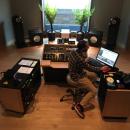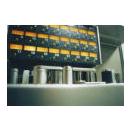Esto obviamente solo puede pasar en digital.
En analógico ni pensarlo.
En analógico ni pensarlo.



alex-p escribió:el hecho de sobrepasar o sacar chicha a una mezcla?






alex-p escribió:Hablando del zero y de las relaciónnes que hay entre software, el Samplitude y una Linx aes 16 conectado juntos de serie
Harán q el 0dbu del soft se convierte en 0dbfs es decir que sin alterarion de preferencias si Mezclas por encima del 0dbu lo que no afecta para nada el Samplitude si afectará los aparatos digital o convertidores conectado a la salida de la lynx
No es asi con todos los Daw y tarjeta de sonido

Alguien escribió:A logarithmic voltage ratio with a reference voltage of V0= 0.7746 volt ≡ 0 dBu
dBu represents the level compared to 0.7746 Volts RMS with an unloaded, open circuit, source (u = unloaded).
Alguien escribió:dBFS - dB Full Scale
0 dBFS represents the highest possible level in digital gear. All other measurements expressed in terms of dBFS will always be less than 0 dB (negative numbers).
0 dBFS indicates the digital number with all digits ="1", the highest possible sample.
The lowest possible sample is (for instance for 16 bit audio):
0000 0000 0000 0001, which equals -96 dBFS. Therefore the dynamic range for 16-bit systems is 96 dB. For 20-bit digital audio it is 120 dB. For 24 bit digital audio it is 144 dB.
Full-scale input level is the analog input voltage level that will cause the A/D converter to just equal full scale with no clipping on either positive or negative peaks.
Output full scale is defined as the analog output voltage produced while playing a 997 Hz digital full-scale sine wave, assuming the THD+N is less than -40 dB relative to the signal level.
The dynamic range of a digital system is the ratio of the full scale signal level to the RMS noise floor.
 es posible que el idioma te haya jugado una mala pasada, puedes cambiar la exposición del comentario para ver si es posible comprender mejor lo que estas contando? Gracias de antemano
es posible que el idioma te haya jugado una mala pasada, puedes cambiar la exposición del comentario para ver si es posible comprender mejor lo que estas contando? Gracias de antemano

Regístrate o identifícate para poder postear en este hilo